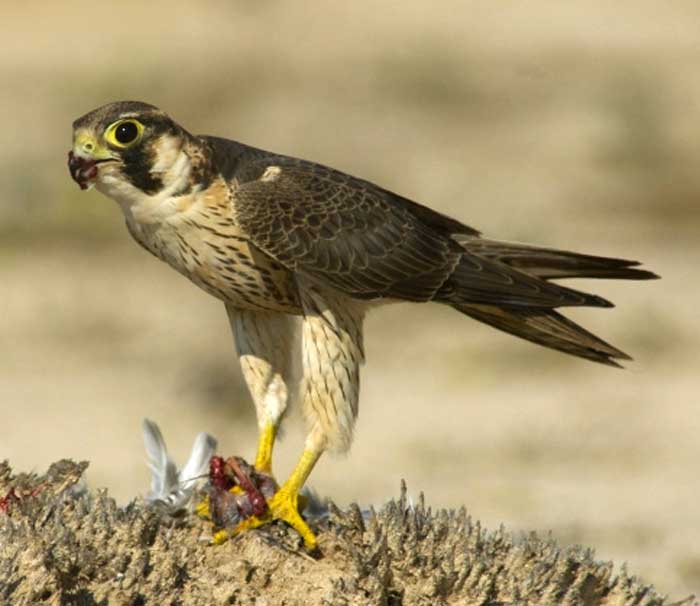Falco pelegrinoides (*) Cladus: Eukaryota Name Falco pelegrinoides Temminck, 1829 References * Pl.Col. livr.81 pl.479
The Barbary Falcon (Falco pelegrinoides) is a medium-sized falcon about the size of a crow. This bird of prey breeds in the Canary Islands and on the coasts of north Africa. It is mainly resident. Description It is a bird of semi-desert and dry open hills. It typically lays its eggs in cliff-ledge nests. The Barbary Falcon is similar to the Peregrine Falcon, but smaller at 33–39 cm length with a wingspan of 76–98 cm. The female is larger than the male. It resembles its relative in general structure. Adults have paler grey-blue upperparts than the Peregrine, and often have a buff wash to the barred underparts, whereas the larger species has a white background colour. The nape is rufous, but this is difficult to see. Sexes are similar, apart from size, but the young birds have brown upperparts and streaked underparts. The streaking is lighter than in the juvenile Peregrine. The call is a high-pitched "rek-rek-rek". Taxonomy The Barbary Falcon differ in appearance from the Peregrine Falcon according to Gloger's Rule. The genetic distance is slight and the species form a close-knit and somewhat paraphyletic group in DNA sequence analyses. They differ more in behavior, ecology and anatomy[2] than usual for conspecifics. They are able to produce fertile hybrids,[3] but they are generally allopatric and only co-occur during breeding season in small areas around Punjab, Khorasan, and possibly the Maghreb and the Mongolian Altai, and there is clear evidence of assortative mating with hybridization hardly ever occurring under natural conditions. In short, though they occupy adjacent territories, they breed at different times of year and Barbary Falcons virtually never breed with Peregrines in nature.[4][5][6][7][8][9][10] Assuming a genetic distance of 2% in hierofalcons[11] corresponds to a divergence roughly 200,000-130,000 years ago,[12] the 0.6-0.7% genetic distance in the Peregine-Barbary Falcon ("peregrinoid") complex [9] suggests its current taxa evolved in the Late Pleistocene some 100,000 years ago or less, but before the Upper Paleolithic. The presumed time of divergence between Peregrine and Barbary Falcons approximately coincides with the start of the last ice age, when desertification was prominent in North Africa and the Middle East, and the Persian Gulf became a landlocked inland sea that slowly dried up. Populations of ancestral "peregrinoid" falcons living in marginal habitat at the fringe of the African-Middle Eastern desert belt either adapted (and might have become isolated e.g. in the Persian Gulf region, which turned into semiarid habitat surrounded by vast deserts), or left for better habitat, or became extinct. During interstadials, deserts receded and the aridland and humidland populations could expand to contact again, causing some limited gene flow. This scenario by and large parallels the proposed evolutionary history of the Saker Falcon in relation to the other hierofalcons; indeed, that group shows similar patterns of molecular paraphyly though it is of somewhat earlier origin.[12] The fossil record adds little to the issue. A humerus some 9,000 years old (i.e., after the last ice age) from the Aswan area in Sudan, where Falco peregrinus minor occurs today, was identified to belong to the Peregrine.[13] The Barbary Falcon is one of the rare cases that may arguably be considered a species under the Biological, but certainly not under the Phylogenetic Species Concept rather than the other way around as usual. This case demonstrates that what makes a "species" is not only its descent, but also occurs to a population in the course of evolution, how it adapts, and how this affects its reproductive isolation (or lack thereof) from sister taxa. Notes 1. ^ BirdLife International (2004). Falco pelegrinoides. 2006. IUCN Red List of Threatened Species. IUCN 2006. www.iucnredlist.org. Retrieved on 12 May 2006. Database entry includes justification for why this species is of least concern
* Helbig, A.J.; Seibold, I.; Bednarek, W.; Brüning, H.; Gaucher, P.; Ristow, D.; Scharlau, W.; Schmidl, D. & Wink, M. (1994): Phylogenetic relationships among falcon species (genus Falco) according to DNA sequence variation of the cytochrome b gene. In: Meyburg, B.-U. & Chancellor, R.D. (eds.): Raptor conservation today: 593–599. PDF fulltext Source: Wikipedia, Wikispecies: All text is available under the terms of the GNU Free Documentation License |
|

